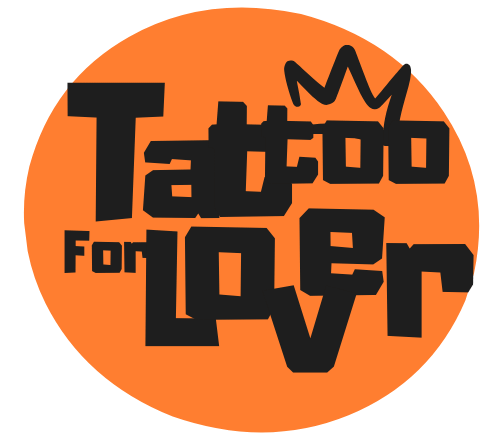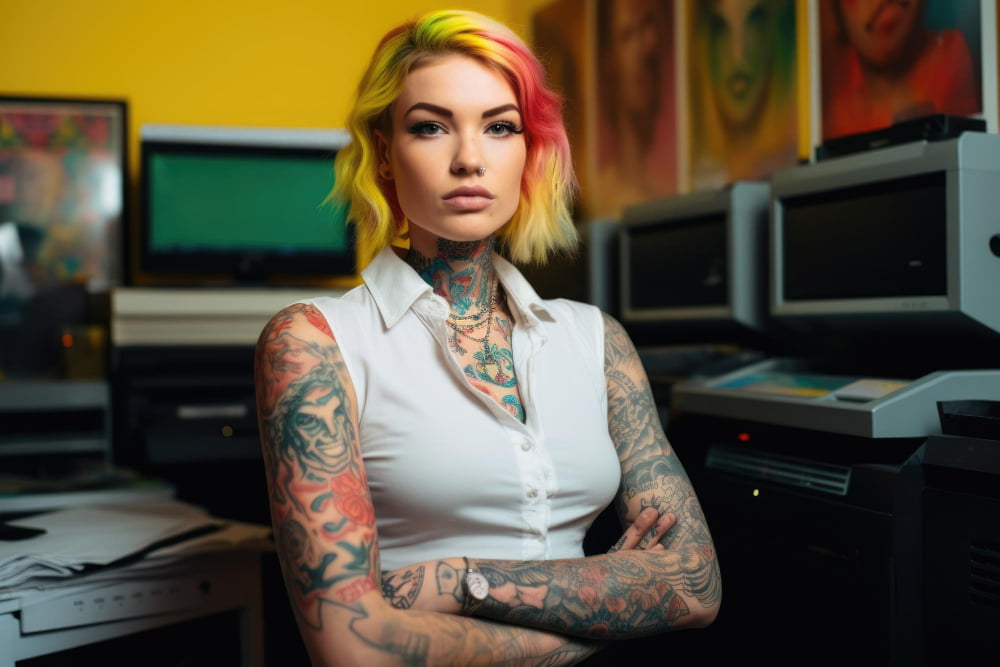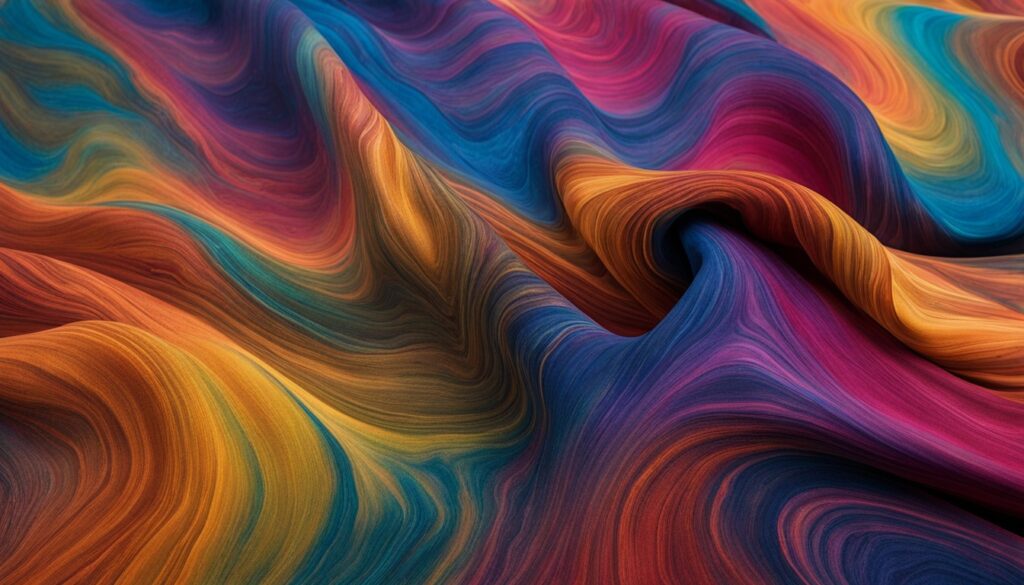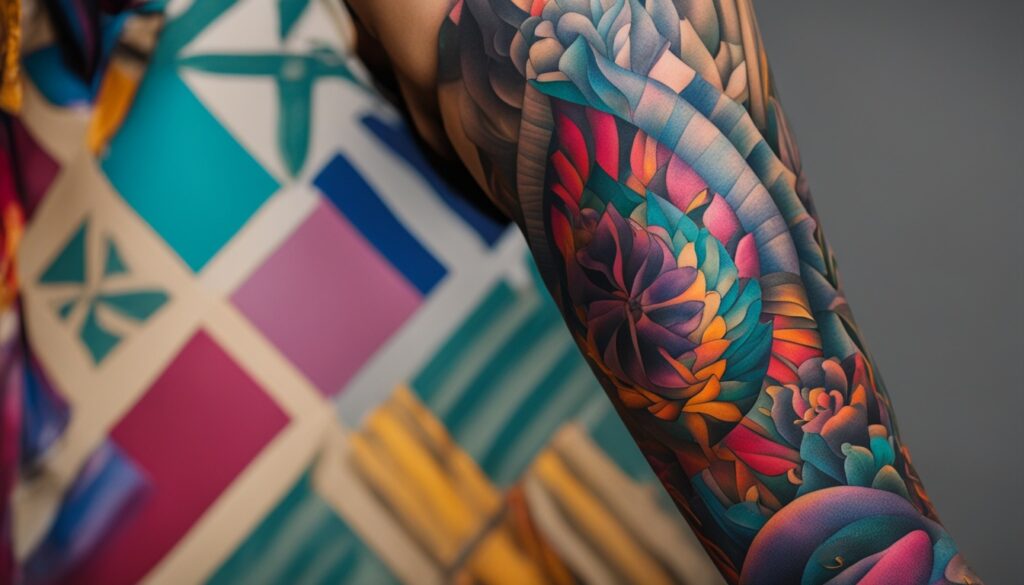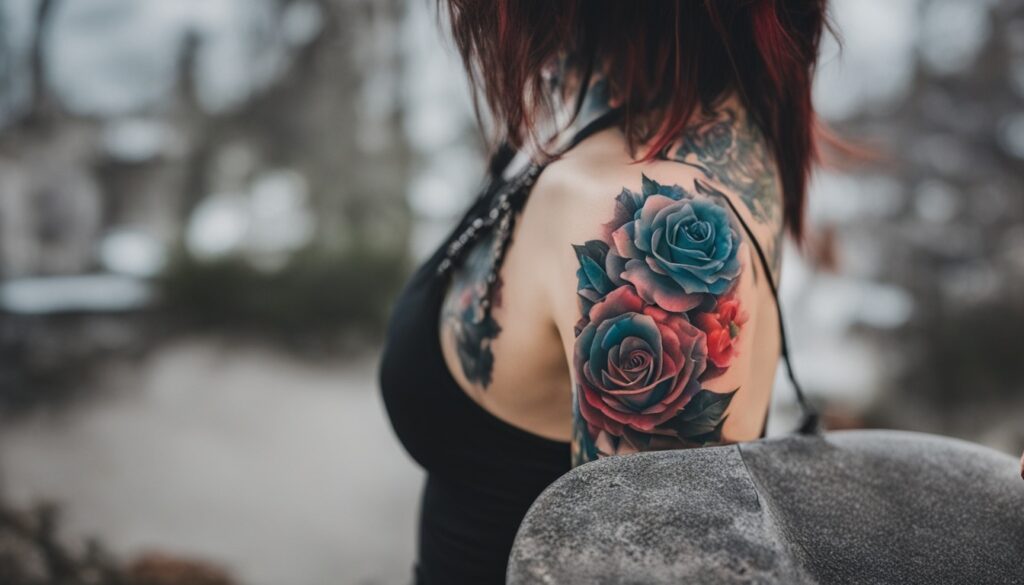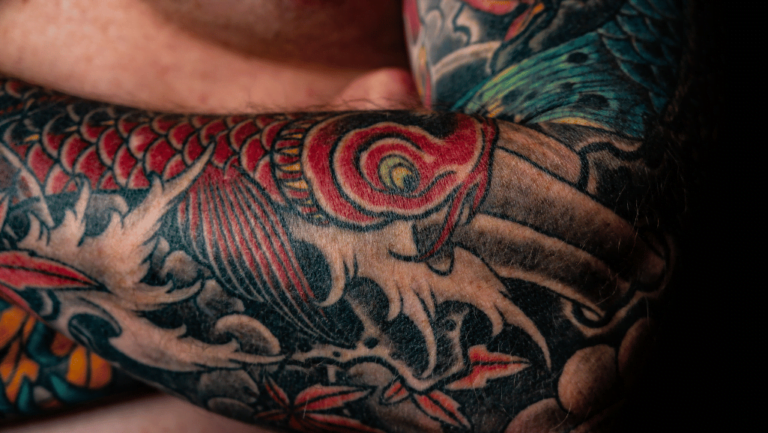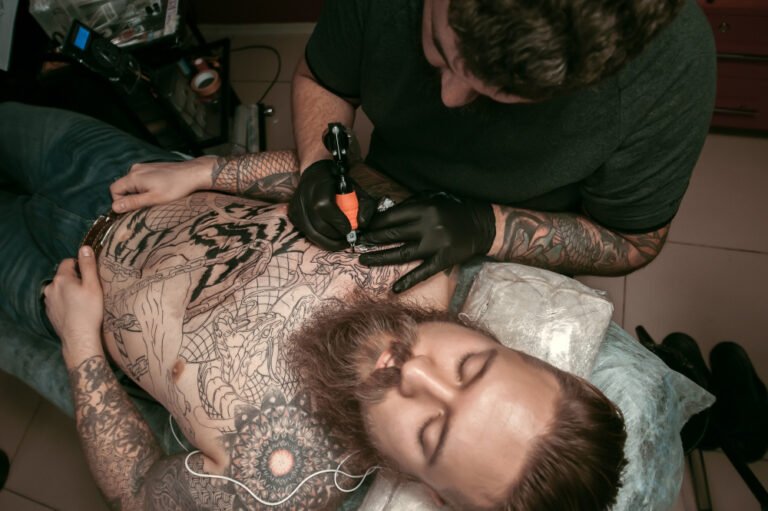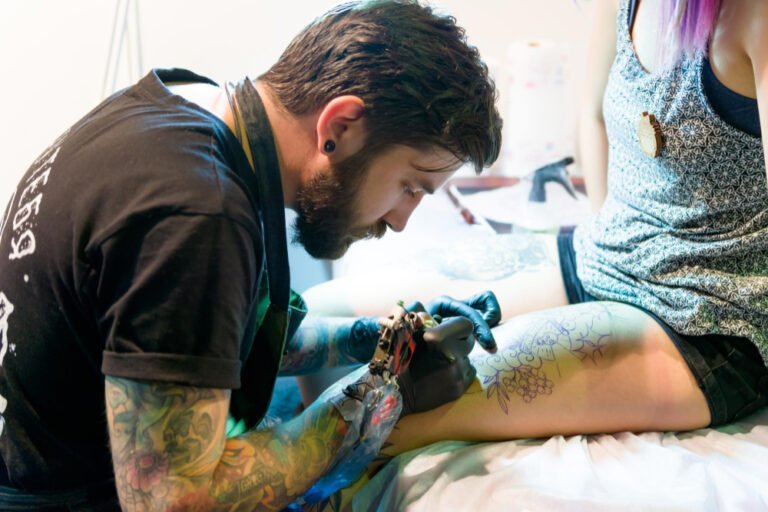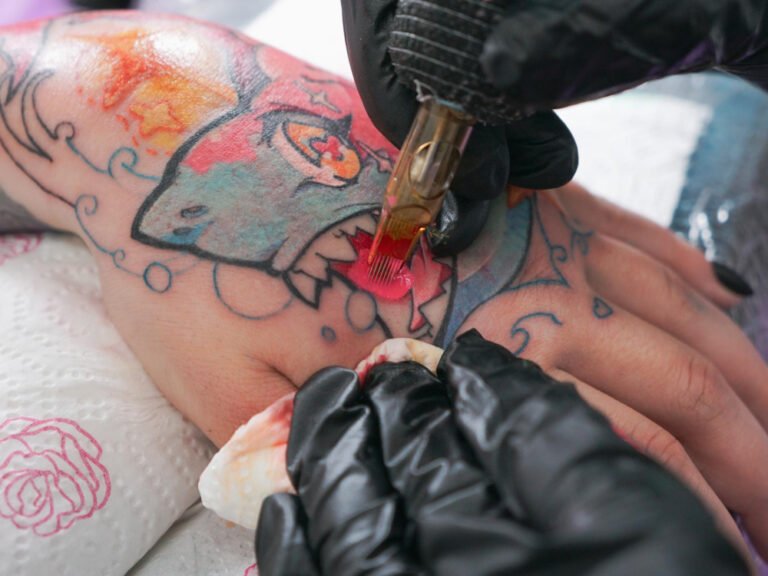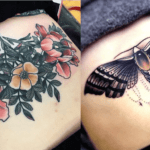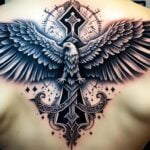Tattoo color variations have grown from symbols of rebellion to signs of self-expression. This change shows how society’s views have shifted. Tattoos, especially colorful ones, have become a way to tell your story since the 1970s. They now show personal growth and mood.
A 2015 Harris poll found nearly 29% of Americans have at least one colorful tattoo design. This shows tattoos are more popular than before. Women now get tattoos too, changing how society views tattoos and tattoo color variations. Tattoos are more than fashion; they tell a story of life’s ups and downs.
Emotional impact of tattoos is huge. Young Americans are getting tattoos to share their stories. This mix of art and emotion helps people express themselves. By choosing colors and designs, they show their inner world on their skin. Tattoos let people tell their stories in a powerful way.
Key Takeaways
- Tattoos have evolved from stigma to mainstream, serving as milestones of personal expression.
- Women’s increasing participation in tattoo culture reflects a significant shift in societal gender perceptions.
- The selection of tattoo color variations offers insight into an individual’s emotional landscape.
- Color plays a crucial role in mood enhancement and the emotional impact of tattoos.
- Data reveals that the prevalence of tattooing is on the rise, with colors playing a major role in burgeoning skin art expressions.
The Cultural Evolution of Colorful Ink Tattoos
Tattoos have a long history, filled with color and variety. They went from ancient rituals to today’s personal expression. This change shows how tattoos have moved from being taboo to being accepted in society.
Tattoos in Ancient Civilizations
In ancient civilizations, tattoos were more than just for looks. They had deep cultural and ceremonial meanings. For example, the Iceman Ötzi and ancient Egyptian mummies show tattoos for health, fertility, and status.
In Greece and Rome, tattoos marked people’s identity and loyalty. In Japan and Russia, they were for criminals and outcasts. This shows how tattoos were used to control and stigmatize people.
Societal Perceptions and Changes over Time
The view on tattoos has changed a lot over time. Once seen as signs of crime or tribal status, tattoos are now more accepted. New technology and artistry have made tattoos a popular form of self-expression.
This shift has made tattoos more inclusive. It celebrates both cultural heritage and individuality.
From Stigma to Mainstream Acceptance
The move from being stigmatized to widely accepted is a big change in tattoo culture. As colorful ink tattoos became popular, society started to see them differently. Tattoos went from being symbols of rebellion to signs of creativity and personal stories.
Now, tattoos are common across all social levels. This shows a big change in how people view and accept tattoos. Today, 32% of people in the U.S. have at least one tattoo. They see tattoos as a way to express themselves.
| Year | Percentage of Tattooed Adults | Reason for Tattoo |
|---|---|---|
| Ancient Times | N/A | Cultural/Social Significance |
| 19th Century | Low | Identification/Art |
| Early 20th Century | Increasing | Military/Identity |
| Modern Day | 32% | Personal Expression |
The story of tattoos shows a big change in how we view them. They’ve moved from being seen as taboo to being celebrated as a form of self-expression.
Color Psychology and Its Influence on Emotions
The world of color psychology shows us how colors affect our feelings and actions. In tattoos, the emotional influence of tattoos is key. It shapes the mood of the wearer and shows their personal story or goals. Colors in tattoos are more than just pretty; they’re tied to feelings that shape our daily emotions.
Looking into color mood impact in tattoos reveals how certain colors make us feel. For example, red can make us feel passionate and full of energy. Blue can make us feel calm and peaceful. This means when someone gets a tattoo, they’re carrying a powerful emotional symbol with them.
| Color | Emotional Influence | Common Tattoo Themes |
|---|---|---|
| Red | Energy, passion, danger | Hearts, roses, flames |
| Blue | Calmness, spirituality, sadness | Ocean waves, sky scenes, religious icons |
| Green | Growth, harmony, health | Nature scenes, leaves, Celtic designs |
| Black | Mystery, elegance, grief | Tribal patterns, lettering, silhouettes |
The psychological effects of color help tattoo artists create designs that touch our hearts. They mix vibrant tattoo colors to make skin tell stories of emotion. For more on picking the right color for your tattoo and its cost, check out how color tattoos are priced.
Tattoos let us share our feelings through color choice. This choice makes the tattoo more beautiful and connects us deeper to it.
Psychological and Psychiatric Perspectives on Colorful Tattoo Designs
In the world of mental health, colorful tattoo designs are seen as more than just pretty pictures. They play a big role in how we express ourselves and our mental health. These tattoos let us tell our stories and share our personal journeys.
Personal Expression and Tattoo Meanings
Tattoos hold deep stories and feelings, making them great for showing who we are. The design, where it’s placed, and the color intensity tell our personal tales or mark important life moments. Psychologists use these stories to understand us better in therapy.
Color Intensity and Mental Health Implications
The bright colors in tattoos can really affect our mood. Bright colors might show happiness and freedom, while darker ones might show strength or sadness. Choosing colorful tattoo designs can be a way to deal with feelings or remember important parts of our mental health journey.
Facilitating Exploration of Self-Identity through Tattoos
Through tattoos, we can show who we are, what we believe, and what we’ve been through. This is especially powerful for those who felt unseen or left out. In therapy, tattoos help us understand and value the many layers of our personality and life stories.
Let’s look at how tattoos play a big part in our lives and in therapy, as shown in this table:
| Statistic | Details | Impact on Identity and Mental Health |
|---|---|---|
| Modern Tattoo Techniques | Electric needle, 2,000 – 4,000 injections per minute | Enables intricate, detailed designs enhancing personal expression |
| Medical Tattoo Uses | Facial scars camouflage, skin tone blending | Improves self-esteem and aids in physical identity recovery |
| Gender Perceptions in Tattooing | Women with tattoos perceived more negatively than men | Affects gender identity and could influence personal mental health discourse |
| Cultural Tattoo Statistics | Rising tattoo rates despite societal stigma | Reflects shifting norms allowing greater self-identity exploration through body art |
This table shows how tattoos are useful and how society sees them. It also highlights how tattoos affect our mental health and identity in many ways. The data show how tattoos and mental health are closely linked, especially through color intensity and psychological impact.
The Artistic Value of Vibrant Tattoo Pigments
In the world of body art, vibrant and quality pigments make tattoos stand out. They turn simple designs into stunning art. Tattoo artists choose colors carefully, thinking about how they look now and later.
Choosing the right tattoo ink is key for a tattoo to stay bright and clear. High-quality pigments resist fading and keep colors rich. They mix colorant with a carrier like alcohol or glycerin for even application and color.
Artists’ Take on Color Palette Selection
Tattoo artists look for inks that stay true to color and are reliable. They pick brands known for quality and consistency. The ink’s alcohol content, pigment load, and carrier ratio affect its stability and look on the skin.
The Relation between Color Richness and Aesthetic Impact
A tattoo’s beauty comes from its color richness. Colors that stay vibrant can make a tattoo look stunning for years. New ink technology helps keep colors bright, protecting the tattoo’s beauty from UV rays and skin changes.
The choice of pigments and color selection is crucial for amazing tattoos. It’s why color richness is key for the look and meaning of a tattoo. As ink technology improves, tattoos will continue to amaze and inspire.
Diversity of Color Palette in Modern Tattoo Trends
In the world of modern tattoo trends, new innovative tattoo shades and techniques have opened up a wide range of colors. Now, people can choose from deep, vivid colors to soft pastels. The modern tattoo industry lets people express themselves in ways never before possible.
Neon colors are making a big splash in tattoos, adding a bold touch to both old and new designs. Soft pastel shades are also popular, great for those who like a more subtle look. They’re perfect for minimalist tattoos.
Butterfly tattoos on the lower back are back in style, mixing old and new trends. These tattoos often use a diverse color palette. This shows how much you can customize your colorful tattoo artwork.
| Tattoo Style | Color Trend | Popularity Context |
|---|---|---|
| Neon Color Tattoos | Bright, Electric Shades | Rising in modern designs for vibrant impact |
| Soft Pastel Tattoos | Subtle, Soft Hues | Preferred for minimalistic and subtle designs |
| Butterfly Lower Back Tattoos | Diverse, Often Vibrant | Resurgence with modern color diversity |
| Illustrative Blackwork | Black with Textured Shades | Continued appeal with modern textures |
| Two-Color Minimalist | Limited yet Striking | Growing popularity for its simplicity and elegance |
The tattoo community is always coming up with new ideas. This means you can find a style that really shows off your personality and style. Whether you like the boldness of neon or the softness of pastels, there’s a modern tattoo trend for you. This lets you express yourself in a unique way.
The Amount of Color Tattoo: How It Interacts with Mood
Tattoos use color in a special way that affects our feelings. Choosing colors for a tattoo is more than just picking a look. It’s a way to change how we feel and share deep emotions. This look into tattoos shows how different colors can change our emotions, using studies and real tattoo examples.
Studies Linking Tattoo Coloration to Mood Alterations
Studies show a strong link between tattoo colors and mood. The colors in a tattoo can really change how we feel. For instance, reds make us feel passionate and full of energy. Blues help us relax.
By picking certain colors, we can make tattoos that match how we want to feel. This lets us control the emotions our tattoos show.
Colors and Their Capacities to Convey Emotional Tone
Colors in tattoos play a big role in how they make us feel. Tattoo artists know a lot about color theory to make tattoos that touch our hearts. For example, tattoos with soft blues and greens can make us feel calm and peaceful.
At Ink Different Tattoo School in places like Brooklyn and Miami, they teach the importance of color in tattoos. They focus on both technical skills and how colors can change our mood. This way, apprentices can make tattoos that look great and touch people’s feelings deeply.
Animal tattoos also show how colors can express emotions. Koi fish tattoos with deep blues and bright oranges can symbolize strength and bravery. This can change the mood of the person wearing it and those who see it.
Knowing how colors in tattoos affect us helps artists and clients connect more with the art. It makes sure tattoos are not just pretty but also touch our feelings deeply.
Incorporating Symbolism through Color in Detailed Color Ink Artwork
Tattoos are more than just art; they tell stories that blend personal tales with cultural history. By using representational colors, they turn skin into a canvas full of symbols. This skillful use of color adds depth, making tattoos a powerful way to express meaning.
Artists with color ink artwork use a range of hues to show emotions and symbols. Deep blues can bring calm and spirituality, while fiery reds can show passion or danger. Each color and design together tells a story, making symbolic tattoos a unique language.
This art is not just about looks; it’s about adding tattoo symbolism that speaks to deep traditions. For example, red in Japanese Irezumi means more than just color; it’s about protection and emotional strength. Green in tattoos can symbolize growth and harmony, important in Irish culture.
Tattooing connects us deeply with our cultural heritage or personal journey.
- Black often stands for power or mourning, with different meanings across cultures.
- White, though rare in tattoos, can mean purity or grief, showing the complex meanings of colors.
Colors in tattoos also have healing effects, using greens and blues to calm and heal the mind.
| Color | Cultural Significance | Emotional Connotation |
|---|---|---|
| Red | Prosperity in Eastern cultures, valor in Native American | Passion, danger |
| Blue | Protection against evil in Middle Eastern cultures | Calmness, spirituality |
| Green | Linked to nature, Irish culture representing luck | Growth, fertility |
Artists use color blending to create custom colors and shades. This makes tattoos modern yet traditional. With digital art and 3D printing, tattoos tell stories with historical and personal depth.
How a Tattoo’s Chroma Level Affects the Perception of Self and Others
The color of a tattoo, known as its tattoo chroma level, is key in how we see tattoos and the people with them. It helps shape our view of tattoos and the people who get them. This color and its hue saturation play a big part in what others think and how they see tattoos as part of personal branding.
Color vibrancy and saturation in tattoos do more than just stand out. They send messages about the person wearing them, like their personality, mood, and creativity. This affects how they see themselves and how others see them.
Impact of Color Vibrancy on Observer’s Perceptions
The perception of tattoos is big on their vibrancy. A tattoo with lots of color is seen as showing a lively personality, full of boldness and new ideas. In social and work settings, these tattoos can really shape first impressions.
The Role of Hue Saturation in Personal Branding
Personal branding with tattoos is big on hue saturation. Bright colors make a statement, showing off a personal or work brand. For those wanting to stand out, knowing how tattoo color and saturation work is key.
| Tattoo Color | Impression on Perception | Usual Brand Association |
|---|---|---|
| Vibrant Red | Energy, Passion | Creativity, Dynamic Leadership |
| Deep Blue | Stability, Trust | Professionalism, Reliability |
| Bright Yellow | Optimism, Cheerfulness | Accessibility, Friendliness |
| Rich Black | Strength, Elegance | Sophistication, Mystery |
Color Saturation and Its Psychological Impact in Tattoo Art
Exploring tattoo colors shows how color saturation deeply affects us. Saturated colors in tattoos mean more than just looks. They carry deep emotional meanings that change how we feel and see things.
Colorful tattoos get their brightness from primary colors like red, yellow, and blue. By mixing these with secondary colors, like orange and green, we get a range from soft to bright. This mix changes the tattoo’s look and feel.
Choosing colors for tattoos changes how we feel. Bright colors give us energy, while softer colors bring calm. These choices affect our mood in big ways.
| Color Type | Emotional Response | Recommended Skin Tone |
|---|---|---|
| Bright, Saturated Red | Passion, Energy | Darker Tones |
| Deep Blue | Calmness, Stability | Lighter Tones |
| Vivid Yellow | Optimism, Happiness | Darker Tones |
Tattoo artists use skin tone to pick the right colors. They adjust the needle’s angle for the best look. This makes the tattoo’s colors pop and changes its emotional impact.
Teaching clients about aftercare keeps tattoos looking bright and full of color. This helps keep the tattoo’s emotional effect. Knowing about saturation of tattoo hues lets artists and clients create tattoos that are both seen and felt deeply.
Choosing the Right Color Spectrum for Your Personal Ink Journey
Choosing the right tattoo colors is more than just picking what looks good. It’s about how your skin tone affects different colors. This choice is key to your tattoo’s look and how happy you’ll be with it.
Guidelines for Selecting Colors for New Tattoos
When picking tattoo colors, it’s important to think about your skin tone. If you have light skin, colors like white or pale blue look great. Medium skin tones work well with vibrant reds, oranges, and greens.
Dark skin looks stunning with darker colors like crimson, black, and dark blue. These colors don’t change much after getting a tattoo. Understanding undertones is also key. Warm undertones go well with warm colors, and cool undertones match cool shades. This makes your tattoo look better and last longer.
It’s smart to talk to experienced artists. They use top-quality ink like Xtreme Ink and Raw Pigments. These inks work well on different skin and have many colors to choose from.
How to Communicate Desired Moods Through Tattoo Colors
Choosing colors for your tattoo is about expressing feelings or messages. Red can show passion and energy, perfect for love or strength tattoos. Blue is calming and often means peace and tranquility.
Talking to your tattoo artist is crucial. Tell them what mood or message you want in your tattoo. They can then suggest the best colors and designs for you. This way, your tattoo will look amazing and mean something special to you.
Your tattoo colors are a big part of who you are. By picking colors that match your skin tone, you get a tattoo that looks and feels right. Whether you like subtle or bold colors, your tattoo reflects your unique personality and feelings.
Conclusion
Tattoos and emotions are closely linked, creating a unique way to express oneself. The choice of ink, whether bright colors or subtle black and grey, shows a person’s personality and feelings. Colored tattoos are lively and artistic but need more care to stay looking good.
Embracing tattoo diversity means seeing the value in all types of tattoos. From simple black and grey to colorful stories, each has its own beauty. Colorful tattoos bring out a bright look after they heal, even if they fade over time. They need special care to stay vibrant, but they add a special touch to our stories.
On the other hand, black and grey tattoos are practical and detailed. They don’t need as much upkeep and look very real. This makes them a great choice for those who want a lasting piece of art.
Tattoo art is always changing, with new technologies like nano-enhanced inks. These new inks make tattoos brighter and last longer while being safer. In the end, tattoos let us tell our stories in a unique way, reflecting our feelings and values. They’re a way to show our individuality and celebrate an ancient art form.
FAQ
How does the amount of color in a tattoo affect mood?
What is the cultural significance behind colorful ink tattoos?
Can the psychology behind different tattoo colors influence emotions?
What do psychological and psychiatric experts say about colorful tattoo designs?
How do tattoo artists decide on a color palette for a tattoo?
How do modern tattoo trends showcase the diversity of color palettes?
Are there any studies linking tattoo coloration to mood alterations?
How can tattoos incorporate symbolism through color?
In what way does a tattoo’s chroma level impact how others perceive it?
What psychological impact does color saturation in tattoos have?
What should be considered when selecting colors for a new tattoo?
How can desired moods be communicated through tattoo colors?
Forhad
Forhad's writing is not just about the artistry of tattoos or the latest trends in the industry; it's an exploration of the deep-rooted connections people have with their tattoos, reflecting personal narratives, cultural histories, and moments of transformation. Through a mix of in-depth features, personal narratives, and insightful analyses, he sheds light on the multifaceted nature of tattooing, revealing the emotional and cultural layers that lie beneath the surface.

